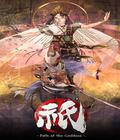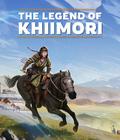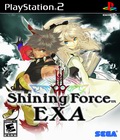Genre: Action/RPG
Publisher: Sega
Developer: Neverland
Release Date: March 20, 2007
The Shining franchise is an expansive series that stretches over a variety of genres, but to this day, many gamers will give you a confused look when asked about it. Starting with the pure Wizardry-like Shining in the Darkness, the series saw brief excellence in the cult-classic Shining Force offerings, loved by turn-based strategy-RPG aficionados due to its simple system and RPG-like stat growth that was nearly unheard-of at that point. However, what came afterwards was the very epitome of the phrase, "How the mighty have fallen."
Camelot, Sega, and other developers have tried to bring back the franchise, with mixed success; most of this is possibly due to every single game with the name "Shining" in it following the same hack-and-slash Diablo-lite pattern. Somehow, fans of the original games keep waiting and hoping for the series to return to its roots. Shining Force EXA is not the game to do that. It adds some strategy into the gameplay, but it's largely the same swords and sorcery beat-'em-up we've seen for several years.
The game is a bit of an odd one from the get-go — even its name is a bit weird. While the American version is known as EXA, perhaps to keep in a vague theme with the former release Shining Force NEO, the original Japanese version was called Shining Force Ikusa, which translates roughly into "Shining Force War." Perhaps there's more than meets the eye?
Indeed there is, as Shining Force EXA tells the story of a young, quite bumbling and rather unlikable warrior by the name of Toma. Now, keep in mind that when the words "rather unlikable" are used, it's almost as if the designers intended for him to be maligned. From the immature, over-the-top voice work, to the cocky, self-absorbed characterization, to the fact that he's the Generic Sword Fighter in every Japanese action RPG in existence (right down to his "a Hot Topic store exploded on me" attire), there's very little that's initially appealing about Toma.
At the beginning of the game, Toma and his traveling companions — a centaurian knight by the name of Gadfort, an elven archer by the name of Maebelle, and the game's other protagonist, a secretive, quiet spellcaster named Cyrille — are seeking the holy sword Shining Force. (Didn't think the game's name would come into play, did you?) The Shining Force is prophesied to give its wielder the power to rule the land — and naturally, in his wonderful fashion, Toma wants it simply because it's a sword and it's neat.
Surprisingly, the Holy MacGuffin the plucky heroes are seeking out is found within an hour of starting the game. Unsurprisingly, the sword (stuck in a stone a la Excalibur) chooses Toma as its wielder and quickly grafts itself to his very soul, manifesting not as a sword, but as a glowing, .hack-esque bracelet. It grants not in itself mythical power, but instead the ownership and control over a large, behemoth-like technomagical war fortress, originally named the Geo-Fortress. In addition, the events connected to the drawing of the Shining Force spark off a worldwide conflict between the kingdom of the humans and that of the humanoids — creatures consisting of everything that walks on two legs (or four, in a centaur's case) but isn't quite human.
Of course, with your shiny new hunk of moving rock, you can put an end to all this, right?
The story isn't the only thing that's cookie cutter. Your choices in character are obvious from the outset; you either pick the quick, bulky, physical swordfighter in Toma, or the more cautious, fragile, magically inclined Cyrille. The other two members of the group work as AI counterpoints to each character, with Maebelle hanging in the back of combat to offer support for Toma, and Gadfort charging in and working to keep Cyrille safe from harm.
The combat is standard action RPG fare. You hit one button for a normal attack, one for skills (weapon-based techniques for Toma, spells for Cyrille), and press certain combinations for special screen-clearing moves. Each character has two other choices for combat; Toma can choose either two-handed weapons or a one-handed sword and shield, and Cyrille can choose spell books, which do minimal damage but allow spellcasting; or crossbows, which allow her to strike safely from a distance without consuming her MP. Additional "equipment" is found to allow Maebelle and Gadfort additional options on how their AI works, making it somewhat customizable.
You can also use the various items you collect and experience you gain on the battlefield to purchase special powers called Power Arts and Secret Arts, which are mostly passive abilities that help you by boosting damage dealt, preventing knockback, increasing maximum HP, and other such nifty effects. Power Arts are character-specific and require special types of experience to purchase, while Secret Arts are modifications to your equipment, costing chunks of Mythril. Luckily, Mythril, while not as common as gold, is still abundant enough that you shouldn't be worried about having to stockpile for the end of the game. In addition, there are other, special types of metal strewn about the world that boosts the power of your Geo-Fortress, bolstering it back up to legendary status.
You'll need all the help you'll get. While one character is out adventuring and questing to save the world, the other has to stay behind and fight off hordes of enemy monsters. It's not a behind-the-scenes deal, either; the game will occasionally rip you out of the quest you're undertaking and place control in the hands of the other character, who will have to close off enemy generators or defeat a monster leader before gameplay can resume. These melees are often quite confusing, having the potential to become 30-man combats or worse. In addition, since your characters level up individually, you're essentially forced to use each character evenly, unless you want a weakling trying to defend your Geo-Fortress.
The practically forced equal-usage setup isn't the only flaw with Shining Force EXA's combat system, either. Remember those 30-monster pileups I mentioned earlier? Well, in order to render each cel-shaded sprite, process its current moves, status, and anything else on the battlefield, the game starts to overwork itself, leading to slowdown of a catastrophic nature, turning the smooth, artistic flow of animation into something more akin to chunky soup. In addition, the game neglects to add any camera control whatsoever, relying on static positioning that is completely unchangeable. After the first 15 minutes of fighting with the right analog stick as many other action RPGs have trained gamers to do with absolutely no effect, you'll slowly start to resign yourself to playing a constant game of "find the main character" in the wide-spanning melees.
It's a shame, as well, as the visuals are the title's truest strength. While the graphics may not be top of the line, the character models and animation are flowing and beautiful, and the use of color shows that whoever was in charge of background design truly knew what they were doing. Spells might be a bit simply animated, and the characters do bear an almost surreal quality similar to those in Breath of Fire: Dragon Quarter, but if you can live with these oddities, you'll find they grow on you to mesh into a sincerely graceful combination.
If only the same could be said about the sound. Yes, the music is relatively inoffensive, but many game soundtracks fall quite neatly under the umbrella of "inoffensive," which could just as easily be labeled "totally forgettable." Likewise, the sound effects aren't anything horribly traumatizing (though Shining Force EXA is home to one of the most limp-wristed crossbow firing sound effects I have ever heard). No, where the real flaw comes into play is in the voice acting. While most modern games range in voice acting from good to tolerable, Shining Force EXA's voiceovers range from "wooden" (Cyrille and Gadfort) to "absolutely atrocious" (Toma).
Despite all its negatives, Shining Force EXA isn't a bad game. It's got all the ingredients for a successful hack-and-slash, but falls short in enough areas to discredit itself to all but hardcore fans of the genre. If you're looking for Sega to come out with another true Shining Force game, you'd be better off not looking here; much like NEO before it, the title has neither the spirit nor the enjoyability of the original series. The game as a whole seems more like an expansion of NEO because there's very little new here, and if you didn't like NEO, you probably won't like EXA. If you can find it on the cheap or as a rental, go ahead and give it a try, but be wary of putting down a full $40-$50 on it, as it's certainly not worth a price tag that size.
Score: 6.0/10
More articles about Shining Force EXA











 SEGA's PS2 exclusive RPG Shining Force EXA plunges gamers into stunning interactive worlds of swords and sorcery, fill with anime cut-scenes that the classic series is best known for. Players take the role of two characters in Shining Force EXA; Toma, a warrior who holds the power to wield the Shining Force, is destined to unite the divided world in which he lives; and Cyrille, a powerful sorceress who fights to create a better future for her homeland. Together Toma and Cyrille embark on a quest to bring peace and order back to their war-ravaged world.
SEGA's PS2 exclusive RPG Shining Force EXA plunges gamers into stunning interactive worlds of swords and sorcery, fill with anime cut-scenes that the classic series is best known for. Players take the role of two characters in Shining Force EXA; Toma, a warrior who holds the power to wield the Shining Force, is destined to unite the divided world in which he lives; and Cyrille, a powerful sorceress who fights to create a better future for her homeland. Together Toma and Cyrille embark on a quest to bring peace and order back to their war-ravaged world.







































